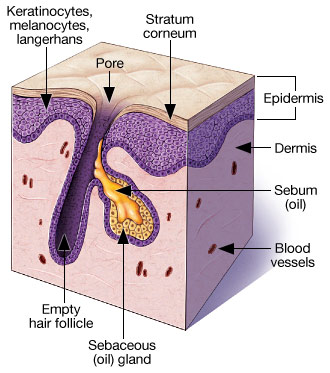Natural Beauty & Your Skin
Tips For Keeping Your Skin Healthy
(Continued)
 |
| Illustration from the book Write Your Skin a Prescription for Change |
Skin, More Than Just A Wrapper
Beyond the critical role skin plays in your appearance, it possesses many impressive functions that have evolved in ways essential to sustaining the human species. Skin is the largest organ in the body and accounts for more than 15% of body weight. It consists of a collection of cells organized into tissues and layers. As you will soon see, this organ is so much more than just a wrapper.
The Epidermis (“epi” – on top of; “dermis” – skin): This outermost part of the skin is 8-10 cell layers in thickness. The youngest cells are at the bottom, moving upward as they mature. Approaching the surface, they die, flatten and “pancake” on top of one another like shingles on a roof to form a tough barrier, called the stratum corneum (“stratum” – layer; “corneum” – cornified or horny). Although composed entirely of dead skin cells, they perform a critical role in retaining moisture for the living tissue beneath and prohibiting the entry of germs and chemicals into our bodies.
The living epidermal cells are in a continuous state of renewal, creating a fresh layer every 28 – 30 days in young people but slowing to 50-60 days by middle age. And when these dead cells don't slough off as rapidly, the epidermis gets thicker leading to a stale, sallow appearance with the dead cells packing into the pores making them look larger.
Langerhans Cells: These specialized cells play a critical role in proper functioning of the immune (resistance) system. As a first line of defense, the Langerhans cells help fight infection and attack potentially cancerous cells. Damage to these cells from chronic sun exposure makes us more vulnerable to disease.
Melanin: Between 5 to 10% of the epidermal cells are melanocytes (“melan” – melanin producing; “cyte” – cell) and are responsible for giving your skin its color. This protective pigment's impact on our appearance is profound and often unpredictable. For example, ultraviolet radiation from the sun or a tanning bed causes these cells to become enlarged and overactive. When this occurs, the development of abundant clusters of pigment (brown spots) is more likely. These are called freckles in a young face and by the not so cute moniker, liver spots, when seen on older adults. With age and the natural loss of melanocytes, the skin becomes lighter, less protected and more susceptible to sunburn. Discrete areas of melanin “burnout” are seen as confetti-like white spots on the arms and legs.
Dermis: The middle layer of skin is made up of sebaceous (oil) glands, sweat glands, hair follicles (sack-shaped cell structures and connective tissues surrounding hair roots) and cells that produce two important structural proteins:
- Collagen, which gives skin its strength and fullness, and
- Elastin, which gives skin its flexibility and stretch.
Both naturally diminish with age and are accelerated by chronic sun/ultraviolet ray exposure. As a result, the smooth taut skin of youth becomes wrinkled, loose and thin.
Where Fat Is Beautiful: The subcutaneous (“sub” – under; “cutaneous” – skin) layer at the base of the skin contains fat cells and deeper hair follicles. Fat gives skin its full, firm cushion and softness. However, this fat is lost naturally with age, causing lips to thin and leaving the face looking gaunt and hollow.
Nature Versus Nurture: Skin ages in two ways: extrinsically and intrinsically.
- Extrinsic (from the outside) aging accounts for 80% of your appearance and is based upon environmental factors such as diet, sun exposure, smoking, alcohol use, sleep patterns and stress — factors under your control.
- Intrinsic (from the inside) or biologic aging accounts for 20% and includes genetic factors, ethnicity, gender and one's health.
It's not about perfect features; it's about rejuvenation without distortion. Aging gracefully is entirely possible and can define natural beauty. Looking good, translates into feeling good which is often transformational. However, artificial beauty, as we so often see in Hollywood, doesn't count. Any five-year-old can easily detect distortion from a too taut face or brow lift or from lips that have been over-plumped. What is amazing is how much you can do without surgery by combining topical treatments, healthy habits and an occasional visit to a dermatologist.
Think of it this way. If you bought a new car and knew it had to last you a 100 years, wouldn't you take better care of it than one you leased for 3 years? Wouldn't you check every rattle, fix every ding, service it regularly and fill it with high-octane fuel? Like this analogy, you must properly care for your body if you want to look and feel great for the rest of your life.
Learn more by reading 10 Tips For Keeping Healthy Skin Healthy.

